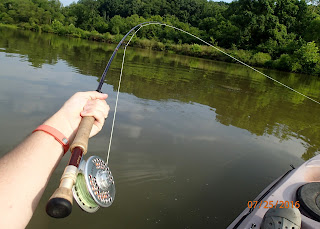Where I am from, it can be fairly difficult to truly "get away." Even on what I would consider to be a remote section of a stream I like to fish, you're never more than a few hundred yards from someone's home or a roadway. You can't escape the noise of the roads, you always have a cell phone signal. A few years back, a buddy I met at a local fly shop got me started fishing a very different stream with him. It's not easy, it's actually hard work. It's a hike to get into the stream after a drive on a single-lane gravel road that borders on being called a path. You're disconnected from the digital world. There's nothing to hear but nature. And the fishing is phenomenal for spotted and largemouth bass. You're not going to pull any 5 pounders out of the place, but 15"+ bass on a lightweight fly rod is a blast. Getting to the stream takes effort, fishing it takes a lot of work, as well. The banks tend to be steep and slick. The foliage around the stream is dense, making casting a typically ugly affair. Just do what you have to do to get the fly where it needs to go. There's swamps. There are hordes of mosquitoes and flies that will make you pay for not using repellent. The payoff makes all of this worthwhile.

This ended up being one of the easier stream access points we found. Flat, stable footing is the exception, not the rule.
A typical stream largemouth, taken on a brown/orange HD Craw pattern.
The foliage along the stream can be navigated carefully, but it's not easy. Pawpaw trees stud the banks all along the stream. Sinkholes along the edges of the bank can wreck your day in a hurry, as well. And get too close to the bank and misstep over the edge, and you'll wind up in the creek faster than you would ever believe (or want to).
A slightly larger than average stream spotted bass. These fish are aggressive, and put up a battle that I think rivals the smallmouth.
This little green sunfish had an appetite bigger than its body. It's also a great example of the diverse bag of fish you can expect to catch. On this trip alone, the species caught were: largemouth bass, spotted bass, green sunfish, longear sunfish, rock bass, bluegill, and crappie. We saw a lot of carp but were unable to get them to take a fly.
This was a solid spot for the stream, right at 15" and it buckled the glass Moonlit 3wt to the cork a few times. This fish took the most popular fly of the day for me, a black/blue HD Craw.
I might be a bit biased, but I think a well-marked longear sunfish is as gorgeous a specimen as you will find anywhere. I consider them Ohio's version of WV's brook trout. They make up for a lack of size with unbelievable coloration and markings.
Another solid spot for this little flow, and another HD Craw victim. This trip was sort of the coming out party for this pattern, and the fly was designed with flows like this in mind.
Fish of the day for both of us ended up being a double we pulled off in a deep run. As I peeked over the stream bank, I located this bass close to the bank and it had no idea we were there. Getting the fly in the water was about all I had to do, and the bass exploded on the fly. As it was hooked and the battle began, another impressive bass tried to steal the fly from my fish. As I worked mine towards the net, my buddy was able to get his fly in front of the other bass and hooked up.
The second half of an impressive 3wt double. Both fish were good examples of why it's worth the effort and weight to carry a good net with an extendable handle. With steep banks and hard fighting fish, that extra reach can come in handy.
By the time we were done, we were both filthy and exhausted. We covered a few stream miles and fished some water that was even new to us. We fell on the muddy banks, nearly stepped in several sinkholes, were bitten by bugs, and were shocked that no rods bit the dust in any of our accidents and missteps. I came home bruised, tired, muddy from end to end, and had a couple of tag-along ticks stuck to me that had to be removed. Most people would never believe you can find this type of fishing in Ohio. In my opinion, it's a great testament to finding your fly fishing adventure closer to home than you might expect. All it takes is a little research and a whole lot of effort.



























